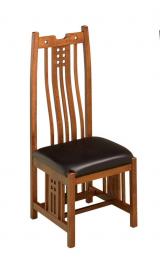The Styles in a nutshell:
Arts and Crafts (A&C): showcasing of joinery, be it mortise and tenon or wedge-pin construction. Simple and utilitarian, though chunkier and more heavy than Shaker furniture.
Mission: straight 90 degree angles, no tapering of legs, slats and rectangular spindles. Royal Mission is another derivative in this vein that has more spindles and some inlay accents.


.




The roots of the styles
The American Craftsman genre was born when Gustav Stickley traveled to England to discover for himself the English Arts and Crafts genre. Craftsman was the chosen title for a movement that emphasized artisanship and showcased the functional wood-joinery that was frequently concealed by other styles. Both Mission and A&C styles emphasize a reduced design: unadorned furniture that allowed the beauty of the wood grain to be showcased. In reaction to the Victorian design movement, the Craftsman movement pushed the pendulum back towards a much understated interior. Idealistically, the craftsman movement was in support of handmade objects and constituted a reaction against the dehumanizing aspects of the Industrial Revolution. Soon the straight lines of the Craftsman styles were labeled Mission--as in the southwest Spanish and Mexican homes around California. Today we can sometimes distinguish between Arts and Crafts and Mission, usually calling something A&C if it has through-tenon joints, subtle arches, and rough hammered metal hardware compared with the angular and clean lines of Mission. In the greater Chicago area there is a lot of architecture with the same heritage--homes and other buildings built with the same Craftsman ideal. Bungalow style homes are especially suited for Arts and Crafts and Mission style furnishings, as the emphasis is on simple and functional living.

